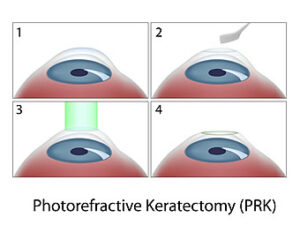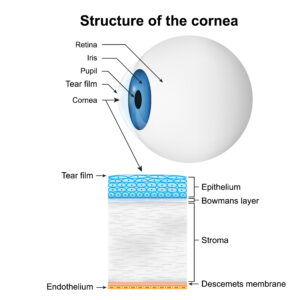Are you wondering if there are other ways to achieve visual freedom besides LASIK? For those that don’t qualify for LASIK, procedures like PRK are worth considering!
PRK is a refractive procedure that’s very similar to LASIK, but it has a few small differences. It’s these differences that make it ideal for people that aren’t good LASIK candidates.
PRK was actually created before LASIK and was the first refractive procedure available. Updated technology and medical advances have made PRK just as effective as LASIK.
Keep reading to learn more about PRK, how it works, and why it could be a good alternative if you don’t qualify for LASIK!
What is PRK?

PRK stands for photorefractive keratectomy. It’s a refractive procedure that changes the shape of the cornea to correct for a refractive error.
Refractive errors include nearsightedness, farsightedness, and astigmatism. These errors occur when the cornea is a slightly irregular shape.
When the cornea is not the right shape, it changes how light refracts through the eye. As a result of this, it makes objects harder to see depending on how far away they are. Removing corneal tissue with a laser can correct the error by sculpting the cornea to a normal shape.
PRK can correct common refractive errors like nearsightedness, farsightedness, and astigmatism. It’s more effective for correcting large amounts of nearsightedness. However, it is still able to correct all refractive errors to a certain degree.
How The Procedure Works
As a procedure, you’ll have PRK performed on an outpatient basis. This means that you can go home after it’s over.

You won’t have to worry about general anesthesia, either, since you’ll only receive numbing eye drops. Having PRK only takes about ten minutes per eye.
Besides receiving numbing eye drops, you may be given a sedative to help you relax. The sedative will keep you awake, since you need to be able to look in the same direction while your surgeon reshapes your cornea.
After the eye drops spread over the surface of your eye, your surgeon will remove the very thin outer layer of protective tissue around your eye called the epithelium. This can be done by using a chemical solution or by simply “buffing” the eye with a surgical tool.
Removing the epithelium is one of the key differences between PRK and LASIK. This is something that only happens during PRK.
After removing the epithelium, your surgeon will use an excimer laser to reshape your cornea and correct your vision. They will then use a soft contact lens, which acts as a bandage on your eye. You’ll be able to go home after resting a bit, although you’ll need someone to drive you.
Candidates
Most healthy adults over the age of 21 who have a refractive error make good PRK candidates. PRK is especially recommended for people who don’t qualify for LASIK due to having thin corneas or other issues.
LASIK and PRK are very similar procedures that both use an excimer laser to shape the cornea. The key difference is that for LASIK, instead of removing the epithelium, the surgeon creates a flap in the cornea.
The flap is then replaced to act as a natural bandage for the eye while it heals. This method works well and can be more comfortable for the patient during the healing process.

It also relies on the patient having a cornea that’s thick enough to create a flap. If the cornea isn’t thick enough, creating a flap can lead to severe visual problems because there isn’t enough corneal tissue to work with during LASIK.
Having a thin cornea isn’t a health concern or something that you would know you have until a LASIK consultation. Some people have thinner corneas than others.
But it can be frustrating when the only thing keeping you from undergoing a vision correction procedure is having corneas that are too thin. But with PRK you don’t need to have corneas that are a certain thickness.
You can have a procedure like PRK and end up with results that are virtually identical to those that you’d get with LASIK.
Results

Recovery from PRK can be a little uncomfortable because your eyes are more sensitive without the outer protective layer. But the epithelium will regrow in about a week, and you’ll be able to resume normal activities within two weeks.
Your eyes will take several months to fully heal, but you shouldn’t notice any discomfort after the initial recovery. Initial recovery from LASIK also takes a couple of weeks.
The eye also takes months to fully heal as the corneal flap needs more time to fuse back to the rest of the cornea. So while LASIK recovery can be easier, this doesn’t mean that it’s any faster than recovering after PRK.
LASIK patients do tend to achieve their best vision after the procedure quicker than PRK patients, but the end results are still the same. After both vision correction procedures, you’ll be able to see better immediately.
Your vision will only continue to get better and better in the following weeks and months. Although LASIK patients reach their peak vision faster, it can still take a few months to get there. In the end, the difference in recovery and healing times between LASIK and PRK are minimal at best.
Patient satisfaction rates are also just as high for PRK as they are for LASIK. PRK patients report a satisfaction rate of over 95% after the procedure!
And like LASIK, PRK is a permanent procedure that alters the shape of your eye, so you don’t have to worry about the results “wearing off” over time. Getting PRK will not correct any future vision problems, meaning you may still develop cataracts or other conditions due to age.
But if you’ve dreamed of visual freedom from glasses and contact lenses, it’s a fantastic way to achieve it!
Ready to find out if a vision correction procedure like PRK is right for you? Schedule an appointment at New England Eye Center in Boston, MA, to learn more now!




